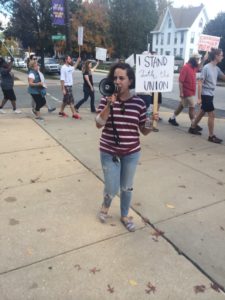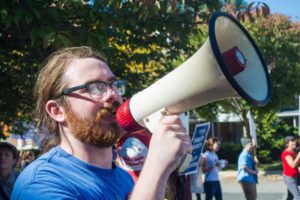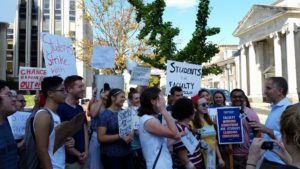
This report on the first-ever strike of the Association of Pennsylvania State College and University Faculties was written by a mobilization co-chair and chant leader who works at West Chester University of Pennsylvania, one of the 14 universities in the Pennsylvania State System of Higher Education.
The union wins
On October 2, around 4 PM, after three days of intense, state wide, picket line mobilization, the first-ever APSCUF strike ended. The Pa. State System of Higher Education forced APSCUF into a strike after proposing 249 changes to the union’s Collective Bargaining Agreement and then refusing to negotiate in good faith for 476 days. Collectively, the State System’s proposed 249 changes to the union’s contract would have severely degraded the quality of higher education in Pennsylvania. The union made some concessions in salary and health care while beating back virtually every other proposal, thereby putting quality first not only rhetorically but in actuality. A few of the proposals APSCUF was able to defeat include:
· Increasing the percent of adjuncts the Collective Bargaining Agreement allows thereby, over time, hiring more and more faculty to be exploited and over-worked
· Allowing the replacement of faculty members with graduate students as instructors of certain undergraduate courses
· Creating a two-tier salary scale that would have divided adjunct and tenure track faculty
· Increasing the number of interns faculty would have to supervise by 67 percent, without addition compensation

Taken together, defeating these 249 proposals preserved the quality of public higher education in Pennsylvania’s State System. Students understood that central issues in the APSUCF strike were protecting the learning needs of students and not allowing the State System to convince the union to sell out adjunct workers. In every action at every stage of the process leading up to the strike ,students participated in solidarity actions.
In an article highlighting student support across all the State System’s schools, published on October 3, a West Chester University undergraduate student, Sabina Sister, commented:
“As our campus moves closer to a strike, it’s about time we send a message to the folks in Harrisburg: bureaucratic, capitalist-fueled, and cowardly agendas will not lead the future of our state system. As students, we have a vested interest in sharing our own thoughts and voices to this fight. When our faculty hurt, we hurt. We are one collective force. We aren’t just educators and students, we are friends and comrades and beneficiaries of one another. Our educators shine lights down paths we cannot yet see. They have taken on the burden that budget cuts have left them. The faculty at our university have made themselves pillars of our personal journeys of triumph and success. We are not naive, we do not see through rose-colored glasses. We, the students of West Chester University, see the actions of Chancellor Brogan exactly for what they are and stand in solidarity with APSCUF.”
Day 1

Sister, a Women and Gender Studies and Political Science major, was one of the key student organizers of the group, Students for Faculty. Their efforts were self-directed. For example, on the first day of the strike, Sister, with bull horn in hand, arrived at the primary picket line location in front Phillips Hall, with a group of around ten students. For the next several hours Sister and faculty members led various chants from, “2,4,6,8, why won’t they negotiate” to “Students for faculty, faculty for students.”
The solidarity was so intense and inspiring that concerns about maintaining a strong and intense presence for the first three days of the strike subsided as it became clear that the energy was escalating despite the 12 hour days many of the organizers and chant leaders were putting in.
The stage was set for this increase in momentum when at 11 AM on the first day Students for Faculty emerged from the center of campus with over 400 students pumping up their own home made signs to the pulsating rhythm of “Students for faculty, students for faculty.” The effect of this action was so awe-inspiring that it brought many faculty members to tears. Some even commented that seeing those 400 students descend through the Phillips archway into the center of our picket line was the highlight of their careers.
The 400 Students for Faculty marched around the entire periphery of the campus for the next three hours inspiring faculty at all of the numerous picket locations located at every university entrance. This three hour action was so powerful and so infectious that it served as the horse that carried us to the finish line.
“Salsadarity”
On two separate occasions during this action a few hundred students and faculty circled up outside the President’s office for an impromptu rally during which students came forward and gave inspiring testimonials explaining why they support APSCUF and their professors.
Shortly after the Students for Faculty action a Habaneros, a six piece salsa band made up of students, arrived at the Philips picket location. They set up in the middle of the picket circle and played for hours, leading chants to the rhythm of their music. They also brought a table, numerous bags of chips, and massive amounts of home made salsa they called “salsadarity.”
For the rest of the day faculty and students continued to rally and keep the pressure up until 7 PM. The lines were held firm from 5:30 AM to 7:00 PM. The media presence was steady all day with coverage ranging from local to national news.
Day 2
On the second day of the strike the lines were formed at 7:00 AM. Just as on the first day, students brought food and drinks plus their own signs and energy to the picket lines.
The support from the larger community was also overwhelming. Nearly every passing car continued to honk in solidarity for a fair contract and for quality education. Labor unions, from the Communications Workers of America to Roofers Local Union #30, also showed their support by refusing to work on campus during our strike as well as bringing donuts and coffee.
Contributing to this momentum we received a report early in the morning on day 2 that our day 1 efforts across the state were beginning to work, forcing the State System to begin to actually to negotiate for the first time in 478 days.
As a result, we began adjusting our chants from “2,4,6,8, why won’t you negotiate” to “2,4,6,8, now you MUST negotiate.” On day 1 we followed this chant by answering the question of why they won’t negotiate with discussions of union busting and transferring education costs to the backs of students and faculty. On day 2 we followed the chant with discussions of the power of our unity in forcing the State System to abandon their attempts to exploit and crush us. Nearly all of our chants followed a similar pattern of revision. That is, we changed our chants as conditions changed. This was an educational lesson faculty and students learned together on the streets through struggle.
On day 1 the evening shift line created a clever chant, “You’re strong, you’re able, come back to the table.” This was a response to the State System leaving negotiations early the day before the strike sending the message that they intended us to walk. The empowering effect of the morning report on Day 2 inspired us to change the chant to “You’re not that strong, but you’re able, come back to the table.” Again, that adjustment was explained as clear evidence that our unity was stronger than the State System, forcing them to come back to the table.
The Students for Faculty group also continued to create actions on day 2. For example, they organized an action in Harrisburg at the state capital, disrupting and shutting down a press conference with a State System spokesman. They successfully drowned him out with the chant, “Not with the media, talk at the table.”
Like day 1, day 2 ended at 7 PM after more student support, faculty musicians and loads of food and solidarity coming from organized labor and the community.
Day 3
On day 3 Students for Faculty were back in full force. By this time a handful of student activist leaders had emerged, shoulder to shoulder with faculty, leading chants, marches, and rallies. At times Sister and undergraduate history major, Ian Gallagher, together would lead one to two hundred faculty in chants as the line moved in a large circle in front of Phillips. This demonstration of student agency and commitment was truly inspiring.
Reports late that morning began coming in that an agreement on a contract deemed fair by our negotiating team was very close. Fueled by the student-heavy picket lines across the state the report provided much needed inspiration to maintain the high level of energy we had been maintaining for three straight days for 12 hours a day.
Around mid-day the WCU marching band came raging in through the arch in Philips playing sections of their songs modified to be protest music in solidarity with APSCUF. Such examples of deep solidarity continued to move faculty and students alike and sustain the momentum until the final word came that an agreement had been reached.
A stronger union
By the end of the first day it was clear to everyone I encountered that the State System’s attempt to break the union had had the opposite effect. That is, people were talking about how the experience of struggling had actually brought us together and made us stronger. We had not just created the conditions for a “fair” contract, we had created a community, a movement. At nearly every picket line located at every entrance around the university, students and faculty played protest music together and received generous donations of food and drinks from the community.
Now that the strike is over faculty and students are talking about organizing a victory march and rally through campus. What is obvious is that we will return to work and to school stronger, more committed, and more clear that through struggle an unjust system can be changed.
Reflecting on the strike experience Sister told Liberation News, “Today, the APSCUF Union that I strongly stand for won their battle against the bureaucratic machine. This fight was won by educators and students, not politicians…” Similarly, Gallagher commented that, “For three days students and faculty stood in solidarity together, to fight for a fair contract for APSCUF. Those three days showed what people power can do, which is bring about real change through direct action.”






